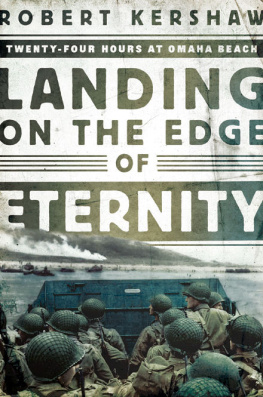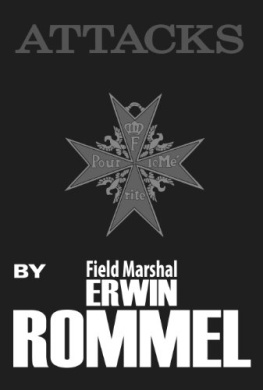Copyright 2013 by Steven Zaloga
Published by
STACKPOLE BOOKS
5067 Ritter Road
Mechanicsburg, PA 17055
www.stackpolebooks.com
All rights reserved, including the right to reproduce this book or portions thereof in any form or by any means, electronic or mechanical, including photocopying, recording, or by any information storage and retrieval system, without permission in writing from the publisher. All inquiries should be addressed to Stackpole Books.
10 9 8 7 6 5 4 3 2 1
Library of Congress Cataloging-in-Publication Data
Zaloga, Steve, 1952
The devils garden : Rommels desperate defense of Omaha Beach on D-Day / Steven Zaloga.
pages cm
Includes bibliographical references and index.
ISBN 978-0-8117-1228-6
eISBN 978-0-8117-5277-0
1. World War, 19391945CampaignsFranceNormandy. 2. Rommel, Erwin, 18911944Military leadership. 3. Normandy (France)History, Military20th century. I. Title.
D756.5.N6Z374 2013
940.54'21421dc23
2013010197
This book is dedicated to the memory of my father, Sgt. John Zaloga, who served in the 2nd Battalion, 393rd Engineer Special Service Regiment, and landed on Omaha Beach on D+15, 21 June 1944. Also to my grandfather, Sgt. Frank Zaloga, also a U.S. Army engineer, who landed on Omaha Beach on D-Day.
Contents
Introduction
WHY ANOTHER BOOK ABOUT Omaha Beach? D-Day has been the subject of countless books over the years, and Omaha Beach has been the focus of many. I have written two previous books on the subject: one a short campaign history of Omaha Beach and the other a study of German fortifications on the D-Day beaches. The latter project, in 2004, made me realize that the German perspective of D-Day is usually missing, especially in English-language accounts. Some years ago, I read a book entitled Facing East from Indian Country: A Native History of Early America. It made me realize that a similar perspective of Omaha Beach would be a valuable addition to our understanding of D-Day.
Most of the recent books on D-Day have been first-person perspectives of the heroism and sacrifice of U.S. soldiers of the Greatest Generation. This book avoids this approach since it already has been so amply documented. Instead, my focus in this book is battlefield forensicsnot so much what happened, but why it happened. My intention is to explore some of the most neglected aspects of the Omaha Beach fighting and, most especially, the overlooked German side of the battle.
In this book, I have followed three threads to explore this subject. The severe casualties suffered by American forces have led to the nickname Bloody Omaha. Why were the casualties so high on Omaha compared to the other four D-Day beaches? Not to spoil any surprise, but my conclusion is that the nature of German defenses at Omaha Beach explains much of the casualty disparity. Furthermore, many of the dangerous innovations of the Omaha defenses can be traced back to the actions of Erwin Rommel, the Desert Fox, who was appointed by Hitler to oversee the antiinvasion efforts in late 1943. This provides the second thread of the book. Rommel was not present at Omaha Beach on D-Day, but his actions in the preceding months strongly shaped the German defenses there on D-Day. Finally, I have been struck by the poor visual record of Omaha Beach available in the published accounts. To help illuminate the description of the German defenses on Omaha Beach, I have attempted to present as complete a picture as possible of the numerous fortifications and weapons present on D-Day. Original German photos of Omaha Beach on D-Day are non-existent, but an ample photographic record of the defenses is scattered through many archives, much of the material previously unpublished. To further amplify these images, I have added my own photos of Omaha Beach that I have taken during the course of several visits starting in the 1980s. I also have compiled numerous maps, architectural models, and computer diagrams to illustrate various historical issues raised in the book.
_______________
Due to the Channel storm on 45 June 1944, Rommel assumed a landing was unlikely and took the opportunity for a short trip back to Germany.
Technical Notes
A few technical notes are worth clarifying at the start of this book. I have left most German unit designations in their original German form since they are easy for an English-reading audience to understand, and they help to distinguish between German and American units. For example, I have used 352.Infanterie-Division rather than 352nd Infantry Division. I have made a few exceptions for the sake of clarity, using the alternative form 84.Korps instead of the cumbersome LXXXIV.Korps, and using Army Group B instead of Heeresgruppe B. I have used English spelling for the German ranks even if they are not entirely equivalentso lieutenant colonel rather than Oberstleutnant. Likewise, I have used the more familiar contemporary style of mm (millimeters) for gun calibers rather than the German cm (centimeters)so 50mm gun rather than 5cm gun.
For brevity, the traditional conventions have been used when referring to units. In the case of U.S. units, 2/16th Infantry refers to the 2nd Battalion, 16th Infantry Regiment. The U.S. Army traditionally uses Arabic numerals for divisions and smaller independent formations (29th Division, 741st Tank Battalion), Roman numerals for corps (V Corps), and spelled numbers for field armies (First Army).
In the case of German regiments, an Arabic numeral is used for the smaller formation (company or battery) and a Roman numeral for the battalion. So 2./Artillerie Regiment.352 refers to the 2nd Battery, 352nd Artillery Regiment; II./Artillerie-Regiment.352 indicates the 2nd Battalion, 352nd Artillery Regiment. German field armies are contracted in the usual fashion (7.Armee for Seventh Army).
Regarding the times presented in this account, on D-Day, the Allies were on British Summer Time (A Time). This was Greenwich mean time (GMT) plus one hour. The Wehrmacht operated on the equivalent of British Double Summer Time (B Time), which was GMT+2. So an Allied report of a landing at 0630 hours would be reported by the Germans as 0730 hours. However, some German units in France used the local time, which was the equivalent of British Summer Time. For clarity, the times in this book are British Summer Time as used by the Allies.
The author would like to thank several people for their exceptional help on this project. Andrew E. Woods, research historian at the Col. Robert McCormick Research Center of the First Division Museum at Cantigny, was most helpful in providing material from the museums collection. Simon Trew of the Royal Military Academy at Sandhurst was most generous with his help on research material and helpful comments. Thanks also to Richard Anderson, Alain Chazette, Emmanuel Ferey, and David Isby for their generous help on this book.
CHAPTER 1
The Controversy

ON 29 JANUARY 1944, FIELD MARSHAL Erwin Rommel conducted a tour along the lower Normandy coast to inspect the progress of anti-invasion efforts. This section of the coast was locally known to the French as Cte de Nacrethe Pearl Coastbecause of its white sand beaches. His command car stopped on the bluffs between the small towns of Colleville-sur-Mer and Vierville-sur-Mer, where he looked out over a flat length of beach. This particular beach was called the Plage dOrthe Golden Beachby the local inhabitants. It stretched for about five miles, bounded by high cliffs on either side. It was a popular summer resort for Parisians, and there were numerous cottages along the coast. He was accompanied by the staff of the unit defending this sector, Maj. Gen. Wilhelm Richters












